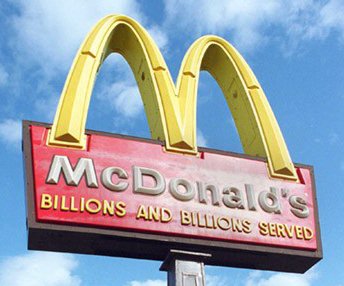
INDIAN RIVER COUNTY – You know you are in a small community when the biggest issue before the county commission is whether McDonald’s restaurants on U.S. 1 at Oslo Road and in Roseland will replace their signs now or later.
That was the controversy that dominated the today’s commission meeting, with an hour-long hearing that included eight comments from the public and remarks from all five commissioners before the board voted unanimously to allow two restaurant signs to remain in place until some later date.
The two McDonald’s recently underwent exterior renovations that a McDonald’s spokesperson characterized as minor. The spokesperson said the permit value of the work was about $125,000 for each restaurant.
Under existing county regulations those upgrades would have triggered a requirement that the main freestanding signs adjacent to the restaurants be replaced with new signs that conform to the Roseland Corridor Plan and a similar plan in the Oslo area.
The corridor plans, put in place during the boom years early in the first decade of the century, are intended to improve the appearance of major thoroughfares by making signs and other exterior building elements conform to consistent standards. In particular, they call for shorter monument-style business signs in place of tall pole-style signs.
The two restaurant owners and their spokesperson said forcing them to replace functional, structurally sound signs valued at $50,000 – $60,000 simply because they spruced up their businesses would discourage other business owners from upgrading their property and adding to the county tax base.
Opponents of the land development regulation change, including Fred Mensing, president of the Roseland Neighborhood Association, painted a dire picture of what would happen if the variance was allowed, foretelling an apocalyptic landscape of huge new signs and endless requests for special consideration from other business owners.
Mensing characterized U.S. 1 as neighborhood road and said people who eat at the restaurants already know where they are and don’t need a tall sign to guide them. He pleaded with commissioners not to set a precedent of allowing businesses to evade the requirements of the corridor plan and suggested they would pay a price at election time if they did so.
He said a lot of work had gone into the corridor plan and it was there for a reason and should be adhered to. “We want the pole signs to go.”
Commissioner Joe Flescher pressed the McDonald’s spokesperson to more clearly define the scope of work to satisfy himself it was in fact minor renovation.
The spokesperson said there had been not significant structural changes and that the restaurant kitchens had remained open throughout remodeling, something that would not have been allowed by the state if major renovation had taken place.
Commissioner Peter O’Bryan said the regulations had been put in place in a different economic climate and it would not make sense to discourage business owners from upgrading property is a weak economy by forcing adherence to rules meant to govern a development boom.
Commissioner Wesley Davis said he believed the regulation was meant to prevent new pole signs from being built, not to force the replacement of existing signs.
County Planning Director Stan Boling emphasized that no new pole signs would be allowed and said that new or rebuilt McDonald’s restaurants would be required to have the approved monument-style signs.
With that, commissioners voted and the momentous decision was taken to allow the existing signs to remain with the proviso that the store owners consult with county staff about appropriate upgrades to the sign bases to make them more attractive.



